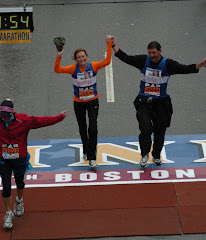 For the last 6 years I’ve used this post-marathon blog to give insights to what race day in Boston is like and how I did personally in attempting to achieve the finish line. This one will be different.
For the last 6 years I’ve used this post-marathon blog to give insights to what race day in Boston is like and how I did personally in attempting to achieve the finish line. This one will be different.When I sat down to write this blog I found myself just staring at the screen. Even days later I’m at a loss to organize and express the range of emotions of the day and days that followed. So I’ll ask your forgiveness in advance if you find this blog a bit unorganized, over emotional at times and lacking the usual humor. I hope it is easier to read than it was to write.
Nervous excitement is the best description I can give for the emotional state of the runners at the staging area in Hopkinton. As I’ve mentioned before, it looks like a mini-Woodstock with runners spread out over the fields and just about every available dry space around the school. Because they close the roads into town at 7:30 most runners have to wait outside for 2-3 hours before the start of the race. That’s a lot of pent-up nervous energy.
I rode out from Boston to the start in Hopkinton with a couple of busloads of charity runners who are part of the Charity Teams group. These are some of the runners who agree to raise $5000 for a race-sponsored charity in order to get an official race number. On my bus most of the runners were first time Boston Marathoners and many were first time marathoners. Susan Hurley is the angel that runs Charity Teams, which trains these runners to be able to complete the run and at the same time helps them with the challenges of fund raising. In the most elite marathon in the world these runners will measure their achievement not by their race times but by the funds that they raised to help others and making it to the finish line.
The weather was perfect and by all accounts this should have been a day of great pride, accomplishment and joy accompanied by runner stories about battling aches and pains, Herculean efforts to conquer Heartbreak Hill, wading through a sea of cups at water stops and humorous costumes and T-shirts. Instead the stories are about the disappointment of being stopped less than a mile from the finish, the fear of not knowing what happened to family members and friends, and the horror of discovering a relative or friend has been injured.
From a running perspective I had a good day. I ran the second half of the race a bit faster than the first half. Tired, sore and happy to have requalified for next year, I shuffled through the post finish line gauntlet where the volunteers hand you water, wrap you in a mylar blanket, give you a bag of post race food and put a medal over your head. All this takes about 15+ minutes and then you enter a section a few hundred yards beyond the finish where you pick up your clothes that you checked in at the starting line. I was standing at that point changing into warm clothes when the explosions went off, the plumes of smoke shot into the air, and the world turned to crap.
 |
| My view towards finish line 10 min after the explosions |
From where we were we couldn’t see beyond the finish line to determine what had happened. I started moving back towards the finish line but the stream of hundreds of incoming runners funneling down the street prevented any movement in that direction. Shortly after, the stream of runners just stopped and first responders had cordoned off the road to keep people out and allow room for emergency vehicles to get in.
 |
| Runners stopped less than a mile from finish. |
Out on the course, the runners had been stopped or redirected to a safe area with little or no information about what was happening. Social media took over and runners with phones began filling in others on what was happening. The cell phone network went to hell as runners tried to call family to let them know they were safe, family members called runners to check on them and runners still on the course tried to arrange logistics to get into Boston or get home. I was waiting at the finish for a friend who I offered a ride home. He was safe over a mile out but it took me almost 30 minutes of dialing and trying to text him to finally get through.
My story was tame compared to some of my friends and acquaintances. A family that until recently lived across the street had a son who graduated high school with my son Nick. He was running and his parents were standing near the finish waiting for him. Both parents are still in the hospital with numerous shrapnel wounds. One of the charity runners from our bus had his wife and kids in the Forum restaurant waiting for him when the bomb went off outside. They were blown off their seats as a hail of glass blew into the restaurant. The mom of another runner from our bus is still in the hospital and was operated on yesterday. The boyfriend of another of the charity runners from the bus lost both his legs.
In the midst of all this tragedy were tremendous examples of selflessness and heroism. Volunteers and spectators around the finish line jumped in to help first responders deal with the wounded without concern there might be a third or fourth bomb. A spectator near the finish jumped the fence and saved the life of one of the injured spectators by putting a tourniquet on his leg and comforting him until first responders could get him to the hospital. It was the boyfriend I mentioned earlier who lost both his legs.
 |
| Forum Restaurant |
So where do we go from here? I’ll make a few predictions. I believe that this will not materially change the format of the Boston Marathon. If that was the goal of the bombers they picked the wrong city and unquestionably the wrong event. We are marathoners;
dedicated, stubborn, passionately addicted to our freedom on the roads and undeniably a little crazy. Not the kind of people that scare off easy.
I believe that this will not reduce either the number of runners or the number of spectators next year. In fact, I expect this will be the best attended marathon in the history of the race. My daughter wrote this assessment from a spectators view http://www.tiffanyschmidt.com/boston-love/ . It eloquently sums up what I heard from many others. I believe that some of the injured spectators will ultimately run the Boston Marathon. On that day I hope to be running along side them to see it.
Finally, thanks to all who reached out to me to make sure I was OK. It was heartwarming to receive all your messages at a really difficult time. Some of you asked if I will be back next year? Absolutely! I’m a runner and when faced with pain and tragedy running is what we do.
Please add your thoughts and comments, they are greatly appreciated, especially after this week.






